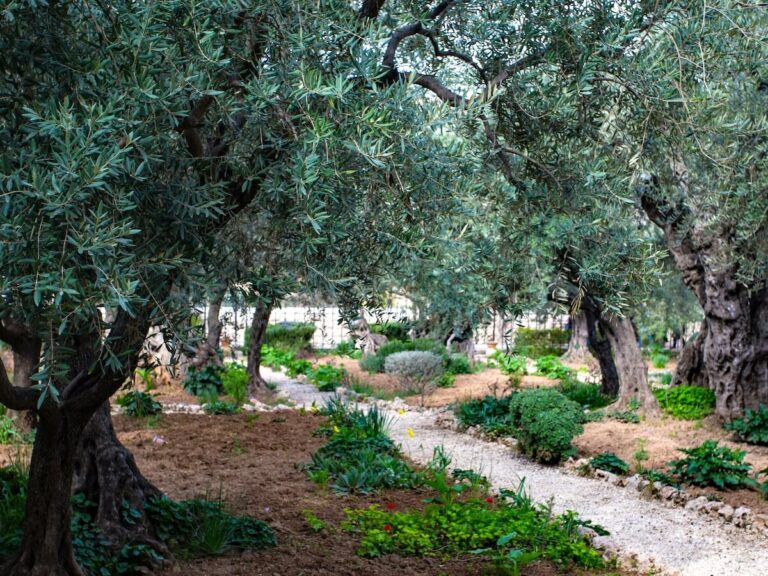Golgotha (Calvary): Everything You Need to Know
The Golgotha, also known as Calvary, is a significant religious site in the Church of the Holy Sepulchre in Jerusalem. It holds great importance for Christians as the place where Jesus Christ was crucified, according to traditional beliefs.
The term “Golgotha” is derived from the Aramaic word for “skull,” and “Calvary” comes from the Latin word “calvaria,” meaning “skull.” This is why the two terms are often used interchangeably.
To fully understand the Golgotha, read on to find out all about it and its significance.
Golgotha Deep Dive
Biblical Significance
Golgotha is mentioned in the New Testament of the Bible, particularly in the Gospels of Matthew, Mark, Luke, and John. According to these accounts, Golgotha was the location where Jesus was crucified. It’s described as a hill outside the city walls of Jerusalem.
Crucifixion Site
The Church of the Holy Sepulchre is believed to encompass both the place of Jesus’ crucifixion (Golgotha) and the tomb where his body was laid after his crucifixion (the Holy Sepulchre). The crucifixion site is marked by a large stone slab called the “Rock of Calvary.” This is where the cross is believed to have been erected.
Chapel of the Crucifixion
Within the Church of the Holy Sepulchre, there is a chapel called the “Chapel of the Crucifixion,” which is built around the Rock of Calvary. The chapel features an altar and is adorned with various religious symbols and artwork depicting the crucifixion of Jesus.
Spiritual Significance
For Christians, Golgotha is a place of deep spiritual significance. It represents the ultimate sacrifice of Jesus for the redemption of humanity’s sins. The crucifixion is a central event in Christian theology, symbolizing the suffering, death, and resurrection of Jesus.
Pilgrimage Destination
The Church of the Holy Sepulchre, including the Golgotha site, has been a major pilgrimage destination for Christians for centuries. Pilgrims from around the world visit the church to pay their respects, meditate, and reflect on the significance of Jesus’ crucifixion and resurrection.
Historical Context
The exact location of Golgotha has been a subject of historical debate. The Church of the Holy Sepulchre was constructed in the 4th century by Emperor Constantine and his mother Helena. While there is no definitive archaeological evidence pinpointing the exact location of the crucifixion, the church has been accepted by many Christians as the traditional site.
Learn more about the history of the Church of the Holy Sepulchre.
Liturgical Observances
Within the Church of the Holy Sepulchre, various Christian denominations hold liturgical observances and services related to the crucifixion and resurrection of Jesus. These services often attract large crowds of pilgrims and tourists, especially during the Easter season. The most famous of these is the Holy Fire Ceremony held annually on Holy Saturday.
FAQs about the Golgotha
People often have questions about the Golgotha in the Church of the Holy Sepulchre due to its historical and religious significance. Here are some frequently asked questions (FAQs) that people might have about Golgotha.
The Church of the Holy Sepulchre is widely accepted as the site of Golgotha, but there is ongoing debate among scholars about its historical accuracy. While some historical and archaeological evidence supports its authenticity, there is no definitive proof.
“Calvary” comes from the Latin word “calvaria,” meaning “skull.” It’s a translation of the Aramaic word “Golgotha,” which also means “skull.” Both terms refer to the shape of the hill or its appearance, which might have looked like a skull.
The Rock of Calvary, believed to be the spot where the cross was erected, is visible within the Chapel of the Crucifixion in the Church of the Holy Sepulchre. However, due to the elaborate decorations and religious items in the chapel, the exact rock may not be entirely visible.
The Church of the Holy Sepulchre is open to visitors. Here you can access the Chapel of the Crucifixion, which contains the Rock of Calvary. Visitors are expected to follow respectful behavior and dress code guidelines, as it is a place of worship.
Start planning your visit to the Church of the Holy Sepulchre.
Golgotha is where Jesus Christ is believed to have been crucified. This makes it a central location in the Christian narrative of salvation. It symbolizes Jesus’ sacrifice for the redemption of humanity’s sins and is a focal point for Christian worship and reflection.
Yes, there have been claims and theories about other potential locations for Golgotha outside of the Church of the Holy Sepulchre. However, this church remains the most widely recognized and visited site associated with Golgotha.
The Church of the Holy Sepulchre is particularly busy during the Easter season, attracting pilgrims from around the world. Special liturgical services, like the Holy Fire Ceremony, and processions take place to commemorate the crucifixion and resurrection of Jesus.
Yes, the church is shared by several Christian denominations, including the Eastern Orthodox, Roman Catholic, and Armenian Apostolic Churches. This shared ownership has sometimes led to tensions and disputes over control and access to different areas within the church.
Learn more about these disputes and the arrangement they landed on, called Status Quo.
The church was built by Emperor Constantine and his mother Helena in the 4th century on what was believed to be the site of Jesus’ crucifixion and burial. It has undergone various renovations and modifications over the centuries.
Archaeological evidence regarding the exact location of Golgotha is limited due to the church’s long history and changes over time. Some discoveries, such as the remains of a quarry and a first-century tomb nearby, have been cited as possible evidence.






